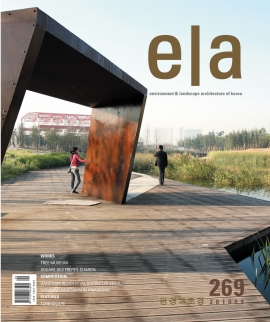기사리스트
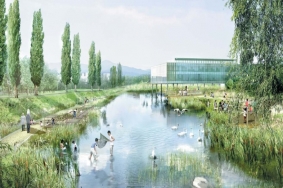
- 화성남양뉴타운 도시개발사업 조경설계공모
- Landscape Architecture Design Competition for Namyang Newtown in Hwaseong고향의 봄당선_서안알앤디 조경디자인㈜설계참여자 _ 신현돈 소장, 박지현, 조현준, 안용재, 송영민, 김정화, 김재영, 우창현, 최웅재, 이지혜, 김소영고향의 봄은 남양뉴타운의 새로운 그린네트워크를 구현하며 시민들에게 향수 어린고향의 안온함과 푸르름을 제공합니다.생태저류지 체육공원은 저관리, 무비용의 멀티필드로 주민에게 활용되며건강채원, 텃밭, 유실수원 등은 토속적인 문화의 경험을 줄 것입니다.천수답 습지와 방죽 물놀이터 등은 생태, 문화의 서정적 경관을 연출하며녹색도시로서 가치를 더할 것입니다.이는 저탄소 녹색성장과 환경적으로 건강하고 지속가능한Environmentally Sound & Sustainable Development 공원녹지체계의 미래상을 보여주는 청청도시로 재탄생 될 것입니다.

- 서부산권 창조마을 아이디어 공모전
- 서부산권, 교육과 창의가 넘쳐나는 곳으로 변모 꿈꿔부산시는 동부산권에 비해 상대적으로 발전이 더딘 서부산권의 발전 요구가 증대되고 도시발전의 패러다임이 생산성의 시대에서 창조성의 시대로 변화됨에 따라 새로운 도시발전방향을 모색해 나가기로 했다. 이에 도시균형발전을 위해 부산시내 북구, 사하구, 사상구 전역에 걸쳐 취약한 주거 및 생활환경을 개선하여 삶의 질을 향상시키고 역사·문화·환경 등의 지역자원을 개발하여 자생적 경쟁력 강화 및 지역발전을 도모하기 위해 3월 1일(월)부터 6월 30일(수)까지 서부산권 창조마을 아이디어를 공모하였다. 모집유형은 특정지역 또는 계층을 대상으로 창의적이고 실행 가능한 프로젝트로서 전통과 현재, 미래의 공존가치 창출을 위한 역사·문화 복원 분야, 도시재생 차원의 생활환경 개선에 공공디자인 개념을 도입한 도시경관·디자인 분야, 상징가로 및 골목길 재생 분야, 창조커뮤니티조성 분야, 사회적 기업 활성화 및 지역연고사업 분야 등을 대상으로 제안하였다. 이번 아이디어 공모에서 대상으로 선정된 팀은 사상구의 새로운 교육 센터를 제안해 기존 학장동의 환경 개선 정책들과 시너지 효과,센터를 중심으로 주변 골목길과 주거 벽면의 개선, 주민들의 자발적 역량강화 등을 보여주었으며, 서부산권에 대한 작은 희망과 향후 부산시가 이끌어갈 창조도시‘부산’의 미래를 제시해 주었다. 편집자주 대상사상구의 새로운 ‘창조교육 마을’ 학장동 E-Co 프로젝트 류영진, 이승윤, 안성배(부산대학교 사회학과)자료제공_ 부산광역시, 금강공원사업소
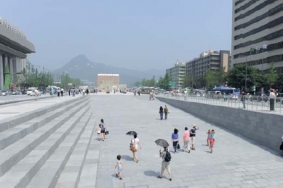
- 조경을 말하다(2)
- 얼치기, 조경을 말하다필자는 이 글을 쓰기 전까지 조경이라는 것이 위의 설명처럼 예술이라기보다는 단순히 겉모습을 치장하는 기술에 불과하다고 생각했다. 조경이라는 단어에서는 전국의 국도 변에 산재한 ○○조경 하는 식의 업체 간판과 함께 어디서 캐왔는지 모를 크고 작은 자연석들과 나무들을 전시해놓은 풍경이 먼저 떠올랐다. 더불어 연상되는 것은 △△아파트 단지 내에 심어놓은 나무들과 그 주위를 둘러싸고 있는 자연석들, 아무개네 전원주택에 심어놓은 멋들어진 조경수들이 떠오른다. 그런데 그런 것들을 보면 하나같이 주변의 생태와는 아무런 연관이 없이 그냥 그 나무만 돋보이게 하거나 보기만 좋게 꾸며놓은 인위적인 조형물 같다는 느낌을 지울 수 없다. 결국 조경이란 단어에서 받는 첫 느낌은 흡사 사람들이 자기 본연의 아름다움을 가꿀 생각은 하지 않고 화장술에만 기대어 자신을 돋보이게 하려는 것과 비슷하게 느껴진다. 이제 그 어설픈 첫 느낌에서 우리시대의 조경의 의미를 조금 더 깊이 생각해본다. 현대적인 의미에서의 조경은 하나의 건물이나 단지 내의 조경보다는 공원이나 하천 같은 오픈 스페이스에서의 조경이 훨씬 더 본연의 의미에 가깝지 않은가 생각한다. 개별의 사적소유에 속해있는 공간보다는 시민들이 휴식과 여가활동 또는 교육 등등의 공적기능을 수행하는 공간의 필요성이나 효용성, 쾌적성 등이 점점 더 중요해지고, 이러한 오픈 스페이스에 대한 사회적 수요가 과거보다 훨씬 더 많아졌기 때문이다.그럼에도 불구하고 우리 사회의 오픈 스페이스는 초라하기 짝이 없다. 일단 잘 조성된 오픈 스페이스가 절대적으로 부족해서 시민들이 다양한 활동을 할 수 있는 공간이 거의 없는 실정이다. 그나마 있는 공원들도 나무 한그루 심어져 있지 않은 콘크리트 광장이거나, 더욱 심하게는 인공적인 그늘조차도 없는 경우도 있다. 넓디넓은 광장을 잔디하나로만 깔아놔서 도대체 어디서 쉬어야 할 지 모르게 만들어 놓고 광장이니 공원이니 하는 이름을 붙이기도 한다.
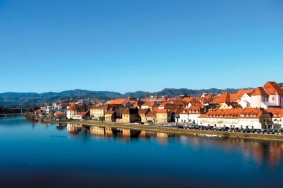
- 보편과 특수: 마리보르 EPK 드라바 2012 공모전
- Maribor EPK DRAVA 2012두 개의 딜레마지난 2009년 12월 슬로베니아의 마리보르라는 도시를 무대로 국제 아이디어 공모전이 열렸다. 공모전의 주제는 마리보르의 중심을 흐르는 드라바(Drava) 강에 대한 다양한 건축적, 조경적 대안을 제시하는 것이었다. 공모전은 크게 세부분으로 나뉘어졌다. 첫 번째 주제는 드라바 강의 호안, 두 번째는 강을 건너는 새로운 보행자 다리, 세 번째는 강변에 세워질 마리보르 미술관이었다. 마리보르는 슬로베니아에서 두 번째로 규모가 큰 도시이지만, 인구는 10만이 조금 넘는 정도의 소도시이다. 지리적으로 슬로베니아의 수도보다도 오스트리아의 대도시들과 더 가까우며 역사적으로도 오랫동안 합스부르크 왕가의 지배를 받아온 이 도시는 마치 독일이나 오스트리아의 도시처럼 보인다. 사진으로 볼 수 있는 마리보르는 중세 시대부터 만들어졌을 것 같은 오래된 도시 조직이 그대로 살아있는 아름다운 유럽의 작은 도시의 모습을 갖고 있다. 우리는 마리보르에서 보편과 특수라는 딜레마를 다시 접하게 된다. 첫 번째 딜레마. 과거의 정체성이 그대로 살아있는 아름다운 소도시 마리보르는 표면상으로는 리쾨르가 저주한 조잡스러운 이류 문명의 질병에 아직 걸리지 않은 듯하다. 마리보르는 새로운 것을 더하지 않더라도 지금 모습 그대로 아름답고 정갈하다. 그렇다면 마리보르는 그 문화적 자원과 정체성을 보존하기 위해 18세기의 모습 그대로 머물러야 하는가? 두 번째 딜레마. 정체성이 이미 비어있는 쥐덫이며 역사의 존재가 현대의 거대 도시에서 관광 상품, 혹은 향수 이상의 의미가 없다는 것을 인정하자. 굳이 지역적 맥락 속에서 과거의 정체성을 존중하는 건축적 양식이 무의미하며 심지어는 우스꽝스럽다는 것에도 동의하자. 그러나 마리보르는 렘 콜하스의 묵시록에 나오는 거대 도시가 아니다. 50년 만에 인구 천오백만의 거대 도시로 성장한 선전(Shenzhen)과 1500년 동안 거의 변화하지 않은 마리보르는 같은 종류의 도시가 아니다. 과거가 소진되지 않고 현재의 토대를 구성하고 있다면 건축은, 조경은, 그리고 도시는 과거에 대해 어떠한 입장을 취해야하는가?
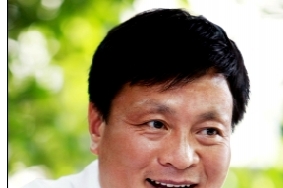
- 인터뷰: 콩지안 유
- Interview: Kongjian Yu, Turenscape콩지안 유1995년 미국 하버드대 디자인대학원에서 박사학위를 받았으며, 1995년부터 1997년까지 SWA Group의 Laguna 사무소에 재직했다. 이후 1997년 북경대학교에 조경대학원을 설립하고 대학원장을 맡아 도시 및 지역계획학을 가르치고 있다. 그는 또한 투렌스케이프를 설립하고 대표를 맡고 있기도 하다. 지금까지 200편 이상의 논문과 16권의 책을 펴내는 등 활발한 저술활동을 보여왔으며, 최근에 펴낸 책으로는『The Art of Survival-Recovering Landscape Architecture』가 있다. 그의 주요 연구 분야는 지속가능한 도시를 위한 조경과 도시계획의 이론과 실제, 문화유산, 조경생태계획 등이다.Kongjian Yu received his Doctor of Design Degree at The Harvard Graduate School of Design in 1995. He joined the SWA Group from 1995 till 1997 in its Laguna office at California. He has been a professor of urban and regional planning at Peking University since 1997, and the founder and dean of the Graduate School of Landscape Architecture at Peking University. He is also the founder and president of Turenscape. Dr. Yu publishes widely, including more than 200 papers and 16 books. His current book is: The Art Of Survival-Recovering Landscape Architecture (The Image Publishing). His major research interests include: the theory and method of landscape architecture and urban planning for sustainable city, the cultural heritage, and landscape ecological planning.올해로 창립 12년, 길지 않은 시간임에도 불구하고 500여 명의 전문 인력으로 구성된 국제적인 디자인 오피스로 발돋움하였다. 급속도로 성장할 수 있었던 원동력은 무엇인가?This year is the 12th year of foundation. It’s not that long time but Turenscape has grown into the international design office with around 500 professionals. what drives your firm to be grown fast?1998년에 설립된 Trenscape는 10년 이상 발전해오면서, 한 개인에서부터 좀 더 다양한 분야의 전문적인 팀으로 이루어진 회사로 성장해왔다. 이러한 빠른 성장에는 두 가지의 주요한 요인이 기여했는데, 그 첫 번째 요소이자 주관적인 요소는 거대한 시장 수요를 들 수 있다. 중국의 전례 없는 규모와 급격한 속도의 도시화는 새로운 경관의 형성과 쇠락한 경관에 대한 복원 분야에서 조경 실무 업체들에게 엄청난 기회를 제공했다. 두 번째이자 역시 주관적인 요소는, 중국이 오늘날 당면하고 있는 과제와 맞닥뜨린 바로 그 시기에 마침 Turenscape가 적합한 자리에 있었다는 것이다. Turenscape의 이념은 대지, 사람, 생태, 문화적으로 민감한 방법, 기술간의 조화를 재창조하는 것을 목적으로 하고 있다. 이러한 요소들 간의 조화는 우리가 시대에 따라 기회를 포착하고 질 좋은 프로젝트를 이루어 내는 것을 가능하게 한다. Turenscape의 디자인은 생태학과 현대 미술의 통합이다. 옴스테드 시대 이래로, 조경에 대한 전문성은 예술적인 자세와 생태적인 자세 사이에서 혼란스러워하는 것처럼 보인다.우리는 사실 ‘생태적 예술’이라는 중도를 택하고 있다. 여기서 중요한 점은 획기적이고 기교가 많은 디자인이 아니라 생태학을 기반으로 해결점을 찾는다는 점이다. 예술성 없이 생태적 자세를 갖는 것은 전문성이 눈에 보이지 않으며 인간의 정체성을 잃게 만들 것이다. 또한 생태성이 없는 기교적인 태도는 윤리적으로 건강하지 못하며 표피적이고 허울뿐인 경향을 보이게 된다. 문화적으로 민감한 자세가 우리 스스로를 전통에 옭아맨다는 의미는 아니다. 우리가 하려고 하는 것은 현대 중국의 토착성과 새로운 미학적 특질을 정의하는 것이다. 우리는 정확하고, 좋고, 아름답기를 바란다. Turenscape was founded in early 1998. Through more than 10 years developing, Turenscape has grown from one person to a multidisciplinary team of more professions. Two major factors contributed to the fast growing of Turenscape. First and subjectively is the huge market demand. The unprecedented scale and speed of urbanization in China create extreme opportunities for the practice of landscape architecture, both in building new landscapes and restoration of degraded landscape. Secondly, and subjectively, Turenscape has rightly positioned at the right time to meet the challenges that China are now facing. It is the Turenscape ideology (see attached), which aims at re-creation of a harmony between land and people and the ecological and culturally sensitive methods and skills that allow Turenscape catch the opportunities and create quality projects through time. Turenscape’s designs are integrations between ecology and contemporary art. Since Olmsted time, the profession of landscape architecture seems to struggle between being art or being ecological. We actually take the middle road, the “eco-art”. The key here is to find solutions based on ecology but with innovative and artful design. Being ecological without art will make the profession invisible and lose the identity of human beings; being artful without ecology is ethically not sound and tended to be superficial an cosmetic. Being culturally sensitive does not mean we are sticking ourselves to the ‘tradition’, what we are trying to do is to define a contemporary Chinese vernacular and a new aesthetic. We want to be authentic, to be good, and then beautiful.대규모 인원이 근무하는 디자인 오피스의 CEO로서 작가적 마인드를 유지하기 쉽지 않을 것 같다. Turenscape가 창조해내는 작품의 디자인은 어떻게 관장하는가?It seems that it’s not easy for you to keep your mind on designing because you are the CEO of design office which has large employers. How do you control the design of works by Turenscape?큰 사무실을 운영하면서 동시에 혁신적이고 질 높은 프로젝트를 수행하는 것은 쉬운 일이 아니다. 요지는 나 스스로 그날그날의 사무실 관리에 시간낭비를 절대로 하지 않는다는 것이다. 운이 좋게도 나는 하루하루의 재정과 개인적 관리를 해주는 팀이 있어서 내가 잘하는 디자인에만 집중하고 있다. 또한 나는 학교처럼 Turenscape의 업무를 처리하는데, 회사의 모든 전문가들이 매우 젊고 배우는데 열정적이며 획기적인 태도를 가지고 있다. 그리고 나 스스로 멘토로서 행동하며 이런 젊은이들을 훈련시키는데 많은 시간을 할애한다. 이는 Trenscape의 이념과도 일맥상통한다고 할 수 있다. 과거에는 비판적인 관점에서 디자인의 질을 다루는 것을 배웠었다. 나는 대개는 사적으로 사이트 답사를 하는데, 언제나 팀을 데리고 다닌다. 그런 후 컨셉을 발전시키고 디자인과정 초기에 그들과 함께 토론의 과정을 거친다. 그 다음에 디자인 과정을 살펴보는데, 원칙은 내 서명이 없는 도면은 사무실 외부로 나갈 수가 없다는 것이다. 나는 특히 완공된 프로젝트에 주의를 기울인다. 프로젝트의 공사가 진행되는 동안 결정적인 단계에 사이트를 방문하는 것은 매우 중요하다. 모든 것을 디자인하려 하면 안 된다. 주의 깊게 살펴보고 건축적이고 구조적인 기술과 디테일을 디자인하되 일이 흘러가는 대로 두고, 시간과 에너지를 효과적으로 쓰는 것이 중요하다.It is not so easy to have a big office and at the same time keep doing innovative and high quality projects. The key is that I myself never wasted my time on day-to-day office management. I am lucky to have a managing team to take care of the daily financial and personnel management, and I concentrate myself on the design, which I am good at. Also, I treat the Turenscape as a school, and all our professionals are very young and they are enthusiastic to lean and to be innovative, and I myself act as a mentor and I spent a lot of time training these young people so that the Turenscape’s ideology can be carried on. In the past years, I have learnt to control the quality of design at the critical points. I usually visit the site personally, and always take a team with me, then develop the concept and discuss with them right at the beginning about the design process. I will then watch through the design processes. The rule is that no drawings are allowed to go out of the office without my signature. I will especially pay attention on built projects. It is very important to visit the site at the critical stage during the construction of the project. Do not design everything, watch carefully and design to the detail the architectural and structural artifices, but let nature to do the work. Spend time and energy efficiently is the key. 그동안 8회에 걸쳐 ASLA Award를 수상하는 등 국제적으로 디자인의 우수성을 인정받고 있다. 특히 2010 ASLA Award 수상작들을 살펴보면 오염된 땅이나 하천, 공장 이적지 등을 생태적·문화적으로 복원하고 지속가능성에 초점을 둔 점이 눈에 띈다. 이러한 프로젝트에서 발생하는 생태적인 시스템과 공간디자인 사이의 충돌을 어떻게 융화시키는가?You’ve won ASLA Award eight times and your design has been internationally recognized. Especially when looking at the prize-winning projects on 2010, it is noticeable to restore contaminated land or brown field ecologically and culturally with focusing on sustainability. How do you make harmony between ecological system and space design in those projects? 우리는 모든 프로젝트를 수행하는데 세 가지 단계의 과정을 거친다.우선, 대상지를 읽고 대상지 자체뿐만 아니라 형태적이고 과정적인 측면에서 지역적인 경관과의 관계를 존중한다. 예들 들어 우수 처리 과정, 생물학적인 과정과 문화적이고 역사적인 과정들을 살펴보면서 문제점들을 파악하는 것이다. 두 번째는 과학적인 이해를 바탕으로 한 해결점을 찾는 것으로 이는 생태적으로 건강한 해결책이기도 하다. 세 번째는 해결책은 반드시 창조적이고 예술적이어야 한다는 것이다. 이것은 공학적인 해결이라는 단순한 개념이 아니라 생태학과 공학, 미학이 통합되어야 한다는 의미이다. 그리고 좀 더 중요한 점은 해결책이 장소와 이용자들에게 진실 되게 다가가야 한다는 것이다. 예를 들어 나는 이국적인 장식물 보다는 그 지역에 있는 소재나 토착 야생 식물을 이용하는 것을 선호한다. 이렇게 하는 것이 사람과 사회 및 환경에 적합하고 경제적이며 아름다울 수 있다. 일반적으로 정확성과 좋음은 정의하기가 쉬운 편인 반면, 아름다움은 정의하기가 좀 어렵다. 그러므로 나는 우선 정확성과 좋은 것을 먼저 고려하고 아름다움이나 예술(예를 들어 레드 리본 프로젝트)은 차후에 고려한다. 나는 나의 접근법을 생태적 미니멀리즘이라 부르고 싶다. 이것은 형태의 측면에서 미니멀리즘을 의미하는 것이 아니라 최소한의 생태적 충격 또는 자연생태적인 과정에 있어 최소한의 간섭, 최대의 이득을 얻기 위한 형태(예를 들어 자연적인 환경기반 위의 조성한 레드리본)를 의미한다.For all those projects, we have three steps to do so.First, you get to read the site and respect the site itself, its relationship with the local landscape in terms of pattern and process. For example the storm water processes, biological processes and the cultural and historical processes, and you identify the problems. Second, you find a solution, which has to be based on scientific understanding, and is ecologically sound. And thirdly, the solution must be creative and artful; it is not a single minded engineering solution, but an integration of ecology, engineering and aesthetic. And more important, the solution must be authentic to the place and the users. For example, I prefer to use local materials and native wild plants but not the exotic ornamentals. It must be good for people, for the society, the environment, inexpensive and it must be beautiful. While authentic and good are usually easier to define, beauty is most difficult to define, therefore I will go for authentic and good first and let beauty or art (such as my Red Ribbon project) follow afterward.I prefer to call my approach as “ecological minimalism”. That is, minimalism not in terms of form, but in terms of minimal ecological impact or minimal intervention to the natural processes and pattern to get maximum benefit (Such as the Red Ribbon in the natural setting). 중국에는 유구한 역사의 원림(전통조경)이 있다. 중국의 현대적 조경을 선도하는 입장으로서 전통 원림과 현대조경 사이의 간극을 어떻게 조율하고 극복할 수 있다고 보는가?There is traditional Chinese landscape “Yuan lin” with a long history in China. As a landscape designer leading a modern chinese landscape, how do you coordinate and overcome the gap between traditional yuan lin and contemporary landscape?중국은 정원설계와 정원예술에 오랜 역사를 가지고 있지만 조경에 대해서는 그렇지 못하다.조경과 정원술(원림)은 많이 다르다. 중국에서 조경이란 기본적으로 새로운 전문 분야이다 보니 명확하게 정의된 실무분야가 필요한 실정이다.나는 지형조작, 도심의 빌딩, 관개 및 농업 등의 생존 기술로 돌아간 중국조경(정원술이 아닌 조경)의 기원에 대해 조사한 적이 있다. 나는 조경은 상류층을 위한 재미를 찾는 정원술에서 그 기원을 찾으면 안 된다고 믿는 경향이 있는데, 중요한 점은 조경은 생존예술인 원림과는 다르다는 것이다.China has a long tradition of garden design and garden art, but not landscape architecture. Landscape architecture and gardening (“Yuan lin”) are dramatically different. Landscape architecture in China is basically a new profession, and still needs more practice to be clearly defined. I traced the origin of Chinese landscape architecture (not garden art) back to the survival art of land making, city building, irrigation and farming. I tend to believe that landscape architecture shall not find its origin in the gardening art of the elite class for pleasure making. The key phrase make landscape architecture different from Yuan Lin is the “art of survival”. 중국은 베이징 올림픽과 상하이 엑스포 등 대규모 국제 행사를 계기로 도시 내 녹지 공간 조성이 한창이다. 이는 각종 도시문제를 해결하고 낙후된 도심을 재생시킬 수 있는 기회라고 생각되는데, 지속가능한 도시 조성을 위해 조경가가 담당해야 할 역할은 무엇이라고 생각하는가?China is at the heights of creating green space in cities because of large scale international events such as Beijing Olympic and Shanghai Expo. It seems to be chances to solve city problems and to regenerate old cities. In your opinion, what is the role of landscape architect to create sustainable city?조경분야는 올림픽 공원과 엑스포공원 같은 큰 행사 조경의 계획과 디자인에 중요한 역할을 해야 한다. 그러나 불행하게도, 중국조경의 전문성은 아직 미흡하고 시장은 시기상조이다.우리가 좀 더 잘 해냈어야 한다고 말하는 것이 슬프다. 우리는 좋은 프로젝트를 수행할 많은 기회를 놓쳤다. 내가 했던 상하이 엑스포 작업은 전체 프로젝트에서 작은 부분에 불과했다. 상하이 엑스포는 조경전반에 걸쳐 좀 더 나은 작업이었어야 했다.Landscape shall play a key role in the planning and designing of these big event landscapes like Olympic park and Expo park. But unfortunately, the profession of landscape architecture in China is still very young and the market is premature, and I am sad to say that we should have done much better, we lost a lot opportunities in dong good projects. What I have done with Shanghai Expo is just a small portion of the whole project. Shanghai Expo should have much better overall landscape.마지막으로 미국을 비롯하여 전 세계적으로 불황을 겪고 있으며 한국 역시 사정이 크게 다르지 않다. 중국 국내의 사정은 어떤지 궁금하며 세계를 무대로 활동하고 있는 당신은 어떤 전략을 가지고 있는지 말해 달라.Lastly, current world including the United States is suffering from the recession. This situation is no different in Korea. We wonder how chinese domestic circumstance is. And as an landscape designer working on world stage, please tell us what your strategic plan is. 중국은 개발도상국이다. 우리의 경제는 미국과 한국처럼 불황을 경험했다. 그러나 우리는 거대한 내수시장 덕에 빠르게 회복할 수 있었다.Turenscape는 불황기 동안 전혀 고통 받지 않았다. 이유는 Truenscape가 중국에서 거대한 환경문제를 해결할 수 있는 위치에 있었기 때문이다. 그리고 경제적 불황기 동안 정부는 대개 환경개선에 투자를 많이 한다. 그래서 우리는 과거보다 더 많은 프로젝트를 했었다. Turenscape는 미국 같은 다른 나라의 클라이언트로부터 지속적으로 의뢰를 받고 있다. 우리는 해외 프로젝트를 선별적으로 수행한다. 이는 중국에 해결해야 할 더 큰 문제들이 있기 때문이고, 또한 덜 도전적인 해외프로젝트를 하면서 시간을 낭비하고 싶지 않기 때문이다. 사실 그런 프로젝트들은 에너지를 너무 많이 소모하게 한다. China is a developing country, and our economy had experienced the recession together with US and Korea, but we quickly recovered due to the huge domestic market. For Turenscape, we did not suffer anything during the recession at all. The reason is that Turenscape has positioned itself in solving the big environmental problems in China. And during the economic recession, the government usually invests much more on improving the environment. Therefore, we even got more projects in the past year. Turenscape has been invited continuously by clients from other countries, such as US, and we are very selective in doing projects abroad. The reason is that China has much bigger problem to solve and we do not want spend too much time doing less challenging projects abroad, which actually distract too much of my own energy. 번역(Translation) _ 서화현(Hwa Hyun Seo)본 내용은 인터뷰 전문입니다. 보다 다양한 이미지는 월간 환경과조경 9월호에서 확인할 수 있습니다.
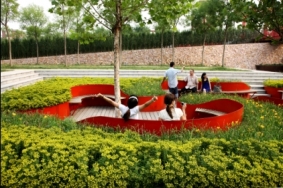
- 톈진 브리지 가든
- Tianjin Bridged Gardens여러 개의 연속된 정원이 L자형의 가는 오픈 스페이스를 형성하고 있는 “브리지 가든”은 톈진 도심과 거대한 인공 자연공원인 치아오유안 공원(Qiaoyuan Park) 사이에 위치해 있다. 이 부지는 심각하게 오염되어 있었고 각종 쓰레기가 여기저기 널려 있었으며, 각종 임시 구조물과 함께 슬럼화되어 있었다. 치아오유안 공원과 브리지 가든을 동시에 조성하면서 전체적인 경관은 수질 및 토양 조건의 개선뿐만 아니라 지역의 문화와 경관을 재조명하고 천만 명에 이르는 인근 주민들에게 여가 공간을 제공하도록 설계되었다. 도심과 치아오유안 공원 사이에 있으며 수변에 위치한 이 L자형의 가느다란 오픈 스페이스는 다양한 과제와 기회를 가지고 있었다. ‘어떻게 부지 내 수질과 토양여건에 적응하는 경관을 만들 것인가?’, ‘어떻게 도심과 자연을 연결시킬 것인가’, ‘어떻게 평탄하고 지루한 경관을 흥미롭게 만들 것인가?’ 이에 대한 해답으로 언덕 정원(Hilled Garden), 도시의 창(City Windows), 선큰 정원(Sunken Garden), 테라스형 워터프론트(Terraced Water Front), 하늘 길(Skywalk) 등의 시설이 있는 “가교(架橋)형식의 정원(Bridged Garden)”이 제안되었다. 여러 개의 시설들이 모여 띠 모양의 경관을 이루어 생태, 여가, 아름다움 등 종합적인 서비스를 제공한다. A series of singularly designed gardens form a L-shaped linear open space, namely The Bridged Gardens, located in between the city and a big man-made naturalistic park(The Qiaoyuan Park), in the northern coastal city of Tianjin, China. The site was heavy polluted, littered, deserted, and scattered with slums and temporary structures. While both the Park and The Bridged Gardens were built simultaneously, this landscape as a whole was designed to not only improve local water and soil conditions, but to create an environment that celebrated the local culture and landscapes, and provide recreational opportunities for the surrounding communities of more than ten million residents. Positing in between the city and the man-made natural park, and being at the water front, this L-shaped linear open space is exposed to multiple challenges and opportunities: How to make the landscape adaptable to the site condition of soil and water? How can the city be connected to the nature? How to make the flat and boring landscape interesting? The solution is Bridged Gardens, featured with Hilled Gardens, City Windows, Sunken Gardens, Terraced Water Front and a Skywalk, which all together created a composed band of landscape that provide multiple ecological, recreational and aesthetic services. Landscape Architect _ Turenscape(Beijing Turen Design Institute)Client _ The Municipal Government of Tianjin City,ChinaLocation _ Hedong District, Tianjin City, ChinaArea _ 100,000㎡ (with a park of 400,000㎡)Completion _ 2008. 5
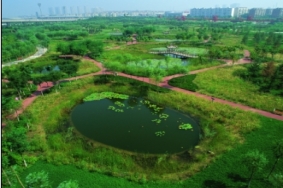
- 톈진 치아오유안 습지공원
- Tianjin Qiaoyuan Wetland Park2010 ASLA Professional Awards General Design 부문 Honor Awards 수상작 쓰레기 처리장으로 쓰이고 있던 방치된 사격장을 재생 설계와 지형 변화를 통해 식물 적응 및 식생군락 진화의 자연적 프로세스를 도입함으로써 유지관리가 손쉬운 도시공원으로 변모시켰다. 이 공원은 우수 집수 및 정화, 염성-알칼리성 토양 개선, 환경교육 기회제공과 소중한 미적 체험과 같은 다양한 자연 서비스를 제공한다. 중국 북쪽의 해안도시인 톈진에 위치한 치아오유안 습지공원은 22ha 규모이다. 급속한 도시화로 인해 교외의 사격장은 쓰레기 처리장이 되었고 도시의 우수 배수지가 되었다. 이 부지는 심각하게 오염되어 있었으며, 빈민가와 쓰러질 듯한 가건물들로 둘러싸여 있었다. 토양은 염도가 높고 알칼리성이었다. 부지 남쪽과 동쪽 경계는 높은 인구밀도를 보였으며 서쪽과 북쪽 면은 고속도로와 고가도로에 접해있었다. 이 프로젝트의 종합적인 설계목표는 도심 우수의 집수 및 정화, 자연 프로세스를 통한 염도 높은 알칼리성 토양의 개선, 관리가 쉬운 천연식생을 통한 경관의 회복, 자연 경관과 시스템에 관한 환경 교육의 기회 제공 등 다양한 자연 서비스를 도시와 주민들에게 제공할 수 있는 공원을 만드는 것이다. 평탄한 지역 경관은 한때 풍부한 늪지대이자 염습지(Salt marsh)였으나 수십 년간 도시개발과 인프라 구축을 위한 건설로 대부분 파괴되고 말았다. 염도가 높은 알칼리성 토양이어서 나무가 자라기 어렵지만, 지하수면과 산성도(PH values)의 미묘한 변화에 따라 지피 식물과 습생 식물들이 풍성하고 다양하게 자라고 있었다.이렇듯 지역에 적응해서 드문드문 자라나고 있던 식생군락에 착안하여, ‘적응의 팔레트’로 명명된 공원 조성 솔루션을 통해 생태계가 다시 작동하도록 설계되었다. 간단한 경관 재생 설계 전략으로, 지름 10~40미터, 깊이 1~5미터의 빈 웅덩이(pond cavities) 21개를 조성하였다. 이 과정에서 나온 부산물은 토목공사를 통해 해결하였다. 일부 웅덩이는 지면보다 아래에, 일부는 마운드 위에 조성되었다. Through Regenerative Design and by changing landforms, the natural process of plant adaptation and community evolution is introduced to transform a former deserted shooting range used as a garbage dump, into a low maintenance urban park; providing diverse nature’s services for the city including containing and purifying storm water; improving the saline-alkali soil, providing opportunities for environmental education and creating a cherished aesthetic experience. This is a park of 22 hectares(54 acres) in the northern coastal city of Tianjin, China. Rapid urbanization had changed a peripheral shooting range into a garbage dump and drainage sink for urban storm water; the site was heavy polluted, littered, deserted, and surrounded with slums and temporary rickety structures, which had been torn down before the design was commissioned. The soil is quite saline and alkaline. Densely populated at the south and east boundaries, the site is bounded on the west and north sides by a highway and an overpass. In early 2006, in response to residents’ call for environmental improvement of the site, the municipal government of Tianjin contracted the landscape architect with the difficult task of an immediate transformation of this degraded site. The overall design goal for this project is to create a park that can provide a diversity of nature’s services for the city and the surrounding urban residents, including: containing and purifying urban storm water; improving the saline-alkali soil through natural processes; recovering the regional landscape with low maintenance native vegetation; providing opportunities for environmental education about native landscapes and natural systems, storm water management, soil improvement, and landscape sustainability; creating a cherished aesthetic experience. The regional landscape is flat and was once rich in wetlands and salt marshes, which had been mostly destroyed by decades of urban development and infrastructure construction. Though it is difficult to grow trees in the saline-alkali soil, the ground cover and wetland vegetation are rich and vary in response to subtle changes in the water table and PH values. Inspired by the adaptive vegetation communities that dotted the landscape in this region, the solution for this park was developed called The Adaptation Palettes, which was designed to let the nature work. A simple landscape Regenerative Design strategy was devised, one that included digging twenty-one pond cavities varying from ten to forty meters in diameter, and from one to five meters in depth. The garbage was handled in the earth work. Some cavities are below ground level and some above on mounds. Landscape Architect _ Turenscape(Beijing Turen Design Institute)Client _ The Municipal Government of Tianjin City,ChinaLocation _ Tianjin City, ChinaArea _ 220,000㎡Completion _ 2008. 10.
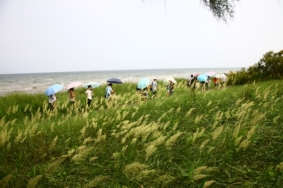
- 친황다오 해변 복원
- The Qinhuangdao Beach Restoration2010 ASLA Professional Awards General Design 부문 Honor Awards 수상작 이 프로젝트는 다양한 재생 설계 기술을 이용함으로써, 심각하게 침식되고 훼손된 해변을 생태적으로 복원하고, 나아가 미적 아름다움과 방문하고 싶은 공간으로 탈바꿈시킨 성공적인 사례이다. 또한 생태적 설계를 통해 인간과 자연의 조화로운 관계를 재건하는 전문적인 시도로서 조경이 그 역할을 할 수 있음을 보여주었다. 해변은 6.4㎞ 길이에 60헥타르 면적으로, 중국 북부 허베이성(河北省)의 해안관광도시인 친황다오(秦皇島)시 발해만(Bohai sea) 해안에 위치하고 있다. 대상지의 모든 부지는 환경적, 생태적으로 훼손된 상태였다. 해안사구는 심각하게 침식되고 해안식생은 썩어갔으며, 해변은 버려진 채 쓰레기로 가득했다. 무분별한 초기 개발로 해안습지가 파괴되고 잔해만 가득했다.이 프로젝트의 목적은 훼손된 자연환경을 재건하여 기존의 해변을 생태적으로 건강하고 매력적인 경관으로 되돌림으로써, 관광객들과 지역주민들에게 원래 부지가 품고 있던 아름다움을 밝히는 데 있으며, 대상지는 크게 3개 구역으로 나뉜다. Zone 1. 침식 방지해안선을 따라 다양한 식생군락과 연결되는 데크(boardwalk)를 설계 해법으로 신중히 제안하였다. 이 데크는 비단 방문객에게 다양한 식생군락을 경험할 수 있도록 할뿐 아니라, 바닷바람과 파도에 의한 침식으로부터 해안선을 보호해주는 이른바 ‘토양보존장치’로도 기능한다.유리섬유를 사용한 생태친화적 기초는 데크가 사구와 습지 위에 “떠 있게” 해준다. 이 유리섬유 기초는 미리 제조된 특별 컨테이너인데, 토양 상태에 따라 비어 있거나 혹은 모래로 가득 채워지게 된다. 이 혁신적인 기술은 현재 조경가에 의해 특허등록이 된 상태이며, 단순히 데크 설치를 쉽게 할 뿐만 아니라 자연환경을 보존하는 시공적 접근이라 할 수 있다. 이는 어려운 과제일 수 있지만 환경 영향을 최소화하여 준다. Using various Regenerative Design techniques, a heavily eroded, badly abused and decaying beach has been ecologically recovered and successfully transformed into an aesthetically pleasing and well visited place, demonstrating landscape architects can professionally facilitate the initiatives of rebuilding a harmonious relationship between man and nature through ecological design. The beach is located along the Bohai Sea shoreline of Qinhuangdao city, a touristic coastal city in North China’s Hebei Province, 6.4 kilometers in length and an area of 60 hectares. The whole site was in an environmentally and ecologically damaged condition. The costal sand dunes were heavy eroded, the costal vegetation was decaying and the beach was deserted and littered; Prior unwise development had destroyed the costal wetland and left it full of debris. The intention of this project is to rehabilitate the damaged natural environment, restore and unveil to tourists and local residents the beauty of the site while transforming a former degraded beach into an ecologically healthy and aesthetically attractive landscape. Zone 1: Erosion protection The design solution has carefully arranged a boardwalk that winds along the shoreline, linking different patches of plant communities. This boardwalk not only allows visitors to experience the different plant communities on the way, but also acts as a soil conservation installation that protects the shoreline from the erosion caused by the ocean wind and weave. Eco-friendly bases are designed using fiberglass that allows the boardwalk to “float” above the sand dunes and wetland. The fiberglass bases are specially prefabricated containers that can be filled with sand or be empty depending on the soil conditions. This innovative and now patented (by the landscape architect) techniques not only makes the process of boardwalk installation much easier in a natural environment than the conventional construction approach, which could be a harder task, but also make minimum impact to the environment. Landscape Architect _ Turenscape(Beijing Turen Design Institute)Client _ The Municipal Government of Qinhuangdao CityLocation _ Qinhuangdao City, Hebei, ChinaArea _ 600,000㎡(6.4㎞ in length)Completion _ 2008. 7.
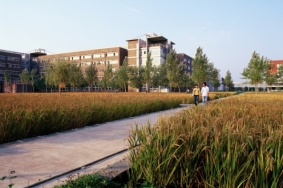
- 선양건축대학교
- Shenyang Architectural University Campus2005 ASLA Professional Awards General Design 부문 Honor Awards 수상작 이 프로젝트는 농촌 경관이 어떻게 도시화된 환경의 일부가 될 수 있으며, 평범한 생산적 경관이 어떻게 문화적 정체성으로 형성될 수 있는지를 보여준다. 중국의 급격한 도시화는 많은 경작지를 빼앗아 갔다. 더불어 13억에 이르는 인구, 제한된 경작지, 식량 생산, 땅의 지속가능한 사용 등은 조경가가 반드시 짚고 넘어가야 할 생존 이슈이다. 컨셉중국의 조경가들은 급격하게 현대화가 진행되고 있는 중국에게 거대한 현안 이슈인 식량 생산과 땅의 지속가능한 이용에 관해 반드시 논의해야 한다. 압도적인 도시화 과정에서 중국 내 많은 논경지가 속수무책으로 침탈되고 있는데, 13억이라는 거대한 인구에 비해 농경지가 단지 18%에 불과하다는 것은 중국이 매우 가치 있고 한정된 자원들을 소진하고 있는 위험에 처해 있음을 보여준다.이 설계안의 개념은 생산적인 경관을 만들어주는 쌀, 자생식물, 농작물의 사용방법을 찾는 한편 환경교육 같은 새로운 역할을 실현시키는 것이다. 또한 이것은 흙을 떠나 도시민이 되는 대학생에게 농사와 땅에 대한 관심을 불러일으키기 위해 설계되었다. 더불어 저비용이며 생산적인 농촌 경관이 섬세한 설계와 관리를 통해 매우 유용한 공간이 될 수 있음을 보여주고자 노력했다. 주요 특징· 캠퍼스의 생산적인 논: 작은 열린 공간들과 함께 캠퍼스를 가로지르는 경관요소가 될 뿐만 아니라 논과 자체 관개시스템을 갖추어 기능적으로도 완전하도록 설계되었다. · 매년 메밀과 같은 다른 자생 농작물이 캠퍼스를 가로지르며 순환하면서 자란다. 자생 식물들은 동선을 따라 선을 그린다. · 경관의 생산적인 측면은 학생과 교직원들을 지속가능한 개발과 식량 생산에 대한 대화속으로 끌어들인다. 새로운 건축대학에 기능적인 논을 도입하여 농사 과정을 명확히 보여줌과 동시에 모든 캠퍼스로 접근을 용이하게 한다. 관리를 비롯해 학생들의 참여는 생산적 경관의 일부가 된다. 농사과정은 학생과 교직원들의 실험실이 될 가능성이 있다. · 대학의 아이콘이 된 황금쌀: 대학 내에서 추수된 “황금쌀”은 학교 방문객들에게 제공되는 기념품이 되었으며, 교외 지역에 새로 설립된 대학의 정체성을 나타내는 자원이 되고 있다. 하지만 무엇보다 더 중요한 사실은 황금쌀의 광범위한 유통이 새로운 하이브리드 경관에 대한 인식을 높였다는데 있다. 이것은 비록 옛것이지만 식량 생산이라는 중요한 기능과 중국의 신진 건축가를 교육하는 기능이 합쳐진 하이브리드 경관이라고 할 수 있다. Project StatementThis project demonstrates how agricultural landscape can become part of the urbanized environment and how cultural identity can be created through an ordinary productive landscape. The overwhelming urbanization of China is encroaching upon much arable land. With a population of 1.3 billion people and limited tillable land, food production and sustainable land use is a survival issue that landscape architects must address. The conceptLandscape architects working in China must address issues of food production and sustainable land use, two of the biggest current issues on China’s horizon as the country moves towards modernization. The overwhelming urbanization process in China is inevitably encroaching upon a large portion of China’s arable lands. With a population of 1.3 billion people, but with only 18% arable land, China is in danger of using up one of its very valuable and limited resources.The concept of this design seeks to use rice, native plants and crops to keep the landscape productive while also fulfilling its new role as an environment for learning.It is designed to raise awareness of land and farming amongst college students who are leaving the land to become city dwellers. In addition, the designer also seeks to demonstrate how inexpensive and productive agricultural landscape can become, through careful design and management, usable space as well. The major features· The productive campus rice paddy: not only designed to be a campus with small open platforms, spanning the landscape, the campus is also a completely functional rice paddy, complete with its own system of irrigation. · Other native crops, such as buckwheat grow in rotation across the campus, annually. Native plants line pathways. · The productive aspect of the landscape draws both students and faculty into the dialogue of sustainable development and food production. By situating a new architecture school within a functioning rice paddy, the design allows the process of agriculture to become transparent and accessible to all on campus. Management and student participation become part of the productive landscape. The farming processes can potentially become a laboratory for students and the faculty as well. · Golden Rice became an university icon: the rice produced on the campus is harvested and distributed as “Golden Rice”, serving both as a keepsake for visitors of the school, and also as a source of identity for the newly established, suburban campus. But perhaps most importantly of all, the widespread distribution of “Golden Rice” could raise awareness of new hybrid landscape solutions that could both continue old, yet crucial uses such as food production, while supporting new uses, such as the education of China’s new architects. Landscape Architect _ Turenscape(Beijing Turen Design Institute)Client _ Shenyang Architectural UniversityLocation _ Shenyang City, Liaoning, ChinaArea _ 30,000㎡(within a campus of 800,000㎡)Completion _ 2004
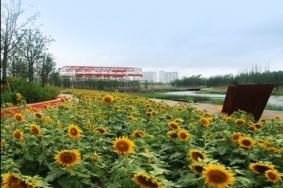
- 상하이 호우탄 공원
- Shanghai Houtan Park2010 ASLA Professional Awards General Design 부문 Award of Excellence 수상작과거 산업부지였던 브라운필드에 만들어진 호우탄 공원은 상하이 황푸 강변 위에 재생된 살아있는 경관이다. 공원의 인공습지, 생태적인 홍수조절, 버려진 과거 산업 구조물과 자재의 재활용, 도시농업 등은 오염된 강을 정화하고 황폐화된 수변을 회복하는 총체적인 ‘복원 설계 전략’의 필수적인 요소가 되고 있다. 설계목적 부지는 14ha의 가늘고 긴 끈 모양으로 중국 상하이의 황푸강 수변을 따라 위치해 있다. 과거 제철공장과 조선소였던 이 재개발 부지는 약간의 산업시설들이 남아 있었고, 주로 산업시설 야적장과 각종 산업 매립지로 이용되고 있었다.이에 공원의 설계 목표로는 ‘녹색 박람회’만들기, 5월에서 10월까지 열리는 박람회 기간 중 밀려올 대규모 관광객을 수용하기, 녹색 기술 선보이기, 잊지 못할 이벤트가 있는 박람회로 만들어 줄 독특한 공간으로의 변신, 박람회 이후 영구적인 수변공원으로 전환 등이 설정되었다. 조성습지 및 재생설계공원의 중심부를 관통하는 길이 1.7km, 폭 5~30m의 선형 인공습지는 황푸강으로부터 유입되는 오염된 물을 살아있는 장치로 정화하는 활기 있는 수변공간으로 만들기 위해 디자인 되었다. 캐스케이드와 테라스는 부영양화된 물에 산소를 공급하여 함유된 영양분을 제거하고 침전물을 제거하는 동시에 공원에 활력을 주는 수경시설이 되도록 했다. 또한 이곳에 여러 종류의 습지식물들을 식재하여 다양한 형태의 오염원들을 흡수하도록 하였다. 현장 실험 결과 하루에 2천4백㎥의 물이 5등급에서 3등급으로 낮아졌다. 이는 엑스포 기간 내내 식수를 제외한 다른 용수로 안전하게 사용할 수 있는 것으로 기존의 수질 정화방법과 비교하더라도 미화 50만 달러의 비용 절감효과가 있다.습지는 또한 20년에서 1000년 주기의 홍수를 방지하는 완충지 기능을 한다. 습지를 따라 굴곡진 계곡은 시각적인 흥미를 일으키고, 레크리에이션, 교육, 연구를 위한 기회인 박람회장의 북적거림으로부터 좋은 휴식처가 되기도 한다. 습지의 테라스 디자인은 도시와 강 사이의 표고차이를 완화시키고, 사람과 수변을 안전하게 연결시켜준다. 더불어 기존의 콘크리트 제방은 서식환경에 좀 더 가까운 쇄석(碎石)호안으로 바꿔 침식으로부터 강변을 보호하고 강둑을 따라 자생종들이 자랄 수 있도록 했다. Project Statement Built on a brownfield of a former industrial site, Houtan Park is a regenerative living landscape on Shanghai’s Huangpu riverfront. The park’s constructed wetland, ecological flood control, reclaimed industrial structures and materials, and urban agriculture are integral components of an overall restorative design strategy to treat polluted river water and recover the degraded waterfront in an aesthetically pleasing way.ObjectivesThe site is a narrow linear 14-hectare(34.6 acre) band located along the Huangpu River waterfront in Shanghai, China. This brownfield, previously owned by a steel factory and a shipyard, had few industrial structures remaining and the site was largely used as a landfill and lay-down yard for industrial materials.The objective of the park design was to: create a green Expo, accommodate for a large influx of visitors during the exposition from May to October, demonstrate green technologies, transform a unique space to make the Expo an unforgettable event, and transition into a permanent public waterfront park after the Expo. Design StrategyRegenerative design strategies used to transform the site into a living system that offer comprehensive ecological services included: food production, flood, water treatment, and habitat creation combined in an educational and aesthetic form. The site is destined to be an innovative demonstration of the ecological culture for the 2010 Expo. Landscape Architect _ Turenscape(Beijing Turen Design Institute)Client _ The 2010 Shanghai Expo Bureau, ChinaLocation _ Shanghai, 2010 Shanghai Expo Park, ChinaArea _ 140,000㎡Completion _ 2010

- 친황다오 식물원
- Qinhuangdao Botanic Garden이 식물원은 중국 북부 허베이성(河北省)동부 해안가의 관광도시인 친황다오(秦皇島)시에 위치해 있다. 총 면적이 26.5ha인 이곳에는 과거 각종 묘목과 성목을 키우는 양묘장과 지금은 파산한 채 오염된 쓰레기 더미로 전락해버린 6개의 작은 공장이 있었다. 이에 식물원으로 조성하자는 안이 제시되었고, 이를 통해 산과 함께 바다로 연결되는 탕허강을 따라 녹색통로(green corridor)로 연결시키고자 했다.“지역 주민들이 자유로이 왕래할 수 있는 공공 오픈 스페이스”, “관광도시 친황다오의 관광객 수용력을 증가시킬 수 있는 관광요소”, “지역 고유 경관에 대한 인식을 일깨워주고 향토 수종과 환경에 대한 교육 시설 도입”이 식물원 설계의 세 가지 목표로 설정되었다. 설계의 주요 개념은 식물 전시와 방문객들의 유희를 가능하게 하는 “풍경(scenes)”과 “장소(setting: 식물원의 부대시설로서의)”로서의 경관의 의미를 회복하고자 했으며, 사람들로 하여금 기분 좋은 경관을 체험을 통해 알게 하는 것이다. 우선 기존에 자라고 있던 대추나무, 등나무, 측백나무, 회화나무가 보존되었으며, 이를 통해 많은 묘목이 식생하게 되었다. 또한 이전 양묘장의 주요 동선들도 유지되어 성목들과 함께 축을 이루는 등 기존의 나무 및 경관 요소들이 세심한 평가를 통해 새로운 디자인에 통합되었다. 한편 다양한 식물 전시방법의 하나로 식물원의 주요 장소(settings)들이 만들어졌다. 대부분의 장소들은 지역에서 볼 수 있는 고유한 경관에서 영감을 얻어 만들어진 것이다. The project is located at the Qinhuangdao City, a tourism city at the east coast of Hebei Province of North China’s. Totally 26.5 hectares(about 65.5 acre) in area, the site is a former tree nursery with some existing seedlings, mature trees and roads, and six small factories that went bankrupted a few years earlier which make part of this site become a garbage dump with degraded environment. A botanic garden was proposed to transform this site, which will also connect the green corridor along the Tanghe River that connects the sea with the mountain. Three objectives are set for the design: An public open space allowing local communities to visit freely; a tourism attraction that can increase the capacity of the city as a overcrowded tourism city; and an educational facility allowing people to learning about the native plants and environment and to be aware of their native landscape. The main concept is to recover the meaning of landscape as “scenes” or “settings” that allow the plants to be displayed and visitors to play, allowing people to learn while experiencing the pleasant landscape. Existing trees and landscape elements are carefully evaluated and integrated into the new design: Existing mature trees on site including Jujube(Zizyphus jujuba), Purple vine(Wisteria sinensis), Arborvitae(Platycladus orientalis), Pagoda Trees(Sophora Japonica) are kept and integrated into the new design, so are many existing seedlings; Major paths of the former nursery are kept because they are lined up with mature trees, which are also integrated into new design. Landscape Architect _ Turenscape(Beijing Turen Design Institute)Location _ Qinuangdao City, Hebei, ChinaArea _ 265,000㎡Completion _ 2009. 7.
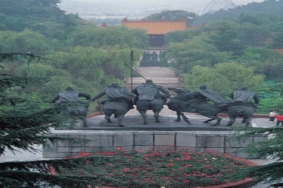
- 이야기 따라 밟아본 삼국지 유적과 경관(6)
- 근거지 없는 유비 서촉행의 시발점이 된 면양 부락산익주 유장 막하의 장송은 처음에는 조조에게 가서 박대를 받았으나 유비의 융숭한 대접을 받고 유비에게 서천(익주)을 취할 방도를 알려준다. 장송은 조조가 서천을 넘보지 목하도록 유비를 불러들이자고 유장을 설득한다. 형주에 머물고 있던 유비는 제갈량 관우 장비 조운을 형주에 남겨놓고 5만 대군을 거느리고 장정에 오른다. 유장은 서촉(서천, 익주)을 차지하려고 온 것도 모르고 충신들의 만류에도 불구하고 유비를 몸소 영접하고자 군사 3만을 이끌고 성도에서 360리 떨어진 부성 城으로 나간다. 두 사람은 형제의 정을 나누며 눈물로 지난 고충을 토로하며 술잔을 기울이지만, 밑의 모사들은 서로 도모하여 후환을 없앨 계책을 마련한다. 방통은 도부수를 매복시켜 유장을 죽이면 힘들이지 않고 서천을 손에 넣을 수 있다고 권하지만 유비는 받아들이지 않는다.이튿날 성중에서는 또다시 잔치가 벌어져 유장과 유비가 자리를 같이 한다. 취흥이 감돌 때 방통은 위연으로 하여금 검무를 추다가 유장을 죽이라 하고, 위연이 칼춤을 추자 유장의 종사 장임이 이를 눈치 채고 같이 검무를 돕는다. 유비와 유장은 대노하여 이를 말린다. 그 뒤로도 유장은 날마다 유비와 더불어 즐겁게 보냈다. -황석영『삼국지』5권에서 요약-
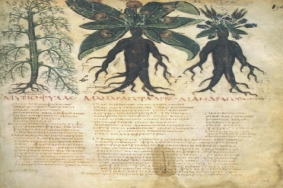
- 고정희의 식물이야기(5): 약용식물이야기, “흙의 꽃”
- -약초를 배우려면 우선 땅을 배워야 한다. -한 이탈리아의 약초전문가 1부: 고대편약용식물의 유래와 역사언제부터 인류가 식물을 의약으로 쓰기 시작했는지 정확하게 밝혀지지 않았다. 어쩌면 인류의 역사만큼 오래된 것일 수도 있다. 한국의 경우 고대 의학에 대한 자체 기록이 없어 처음부터 중국의 영향을 받아 온 것으로 안팎에서 당연시 여기고 있는데 우리의 고대문명에 대한 연구가 빈약하다 보니 고유의 의약이 있었던 것인지 아니면 모든 것을 중국으로부터 받아들였는지 알 도리도, 증명할 방법도 없다. 앞으로 이 방면에서 집중적인 연구가 이루어져서 우리의 깊은 뿌리에 대해 좀 알고 사는 날이 왔으면 하는 바람이다. 우리의 고대의약과 관련하여 유일하게 흔적이나마 엿볼 수 있는 것은 환웅이 신시를 정하고 360가지 일을 맡아 인간세계를 다스렸다는 삼국유사의 기록이다. 그 360가지 일 중에 병을 다스리는 일이 포함되어 있었고 이 때 주술과 약초를 썼을 것은 어렵지 않게 짐작할 수 있다. 더욱이 마늘과 쑥이라는 구체적인 식물이 거론되고 있는 점으로 보아 이들이 과연 곰을 인간으로 만들 수 있을 만큼 신통력이 있었는지는 모르겠지만 마늘과 쑥의 강한 효능에 대한 지식이 존재했던 것은 틀림이 없다. 그러나 한국의 고대의학은 약물요법보다는 주술에 더 크게 의존했을 것이라고 이야기들 하고 있다. 그런데 고대의 주술은 비단 우리나라에 국한 된 것이 아니라 어느 문명권에서건 의술행위와 연계되어 상당히 중요한 역할을 차지했었다. 고대 이집트의 기록을 보면 상처에 가제를 댈 때와 뗄 때 각각 별 개의 주문을 외웠다고 한다2. 그리스에서도 아리스토텔레스의 제자이며 의사였던 테오프라스트가 말하기를 사랑의 약초로 알려진 맨드레이크Mandrake를 캘 때는, 칼로 식물 주위를 세 바퀴 돌리고 얼굴을 서쪽으로 향한 뒤 캐 되, 뒤에서 다른 이들이 춤을 추고 노래를 해야 한다고 했다. 한국의 심마니들이 산삼을 캘 때처럼 길일을 정하고 몸과 마음을 정하게 하며 신령님께 절을 올리는 정도까지는 아니어도 중세 때에는 약초를 캐는 적절한 시간, 계절, 별자리 등에 대한 지침이 따로 있었다.
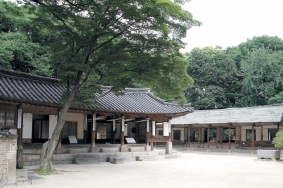
- 연경당
- Yeongyeongdang造營_ 연경당은 순조 28년(1828) 왕세자인 익종1의 청으로 사대부의 생활을 경험하고 이해하도록 하기 위하여 창덕궁의 후원인 금원禁苑내에 건립된 것으로, 연경당의 조영연대를 기록한 문헌으로는 한경지략漢京識略, 궁궐지宮闕志그리고 증보문헌비고增補文獻備考를 들 수 있는데, 한경지략에서는“연경당을 창건한 자조子朝27년은 순조 27년인 정해년丁亥年이며, 창건자는 섭정하는 왕세자인 소조小朝(후일 익종으로 추존) 였으며, 대조大朝인 순조가당호를 연경演慶이라 이름지었다”고 밝히고 있다. 그러나 궁궐지와 증보문헌비고에서는 연경당이 진장각珍藏閣옛터에 후일 익종으로 추존된 왕세자가 세자시절인 순조 28년에 지은 것으로 기록되어 있다. 또한 건축의도에 있어 당시 규범적인 궁집宮家모습을 궁궐 안에 재현함으로써 궁궐 밖 민간생활을 알고자 한 것으로 판단되는 바, 이는 연경당이 당시의 궁집과 사대부의 모습과 유사한 모습을 가지고 있으며2, 서울의 팔대가의 하나였던 경운동의 부마도위駙馬都尉, 박영효의 초기 제택第宅3 이었던 이진승가李珍承家나, 관훈동의 민덕기가閔德基家(竹洞宮), 경운동의 민병도가閔炳道家등과 전체적인 구성이 유사하며, 특히 민병도가와는 안채와 사랑채가 하나의 채로 연속되어 건립된 점이 같다. 1. 익종은 순조 9년에 태어나 순조 27년 왕명으로 대리청정을 하다가 순조 30년(1830)에 세상을 떠났다. 그 뒤 아들이 헌종으로 즉위하자 왕으로 추종되어 익종으로 종묘에 봉향되었다.2. 연경당은 안채, 사랑채, 안행랑채, 바깥 행랑채, 서재인 선향재, 반빗간, 농수정이라는 이름의 정자 등 여러 채(건물), 그리고 그것들과 각각 짝을 이루는 마당으로 구성되었으나, 궁궐 내에 위치한 이유로 인해 일반 사대부집과 달리 사당이 없으며, 안채의 부엌이 없는 대신 음식을 준비하고 빨래와 바느질 등 집안 안살림을 하는 반빗간이 별채로 있다.3. 민가 중 공경대부의 집과 대군이나, 공주의 집인 궁집을 민가와 구별하여 제택(第宅)이라 한다.
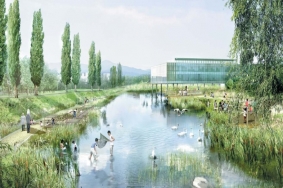
- 화성남양뉴타운 도시개발사업 조경설계공모
- Landscape Architecture Design Competition for Namyang Newtown in Hwaseong고향의 봄당선 _ 서안알앤디 조경디자인㈜설계참여자 _ 신현돈 소장, 박지현, 조현준, 안용재, 송영민, 김정화, 김재영, 우창현, 최웅재, 이지혜, 김소영
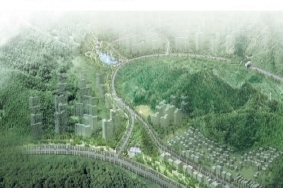
- 서울강남 보금자리지구 조경설계공모
- Landscape Architecture Design Competition for Gangnam Residential District흥이 넘치는 길과 어우러진 풍광만들기구비풍경 당선_동인조경 마당설계참여자 _ 황용득 소장, 김성진, 한지숙, 김병만, 도여형, 이상복, 김종찬, 김선주, 정푸름, 한승지, 이재민, 이유경, 심승기, 이행하, 한준희, 윤미경
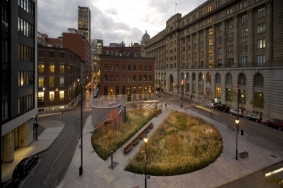
- 페레-샤롱 광장
- Square des Freres-Charon 몬트리올에 위치한 페레-샤롱 광장은 올드 포트Old�a�ort 지역과 현재의 시청을 연결하는 역사적인 간선도로인 맥길McGill로의 축을 따라 만들어진 공공공간 네트워크의 일부이다. 이 광장은 지난 17세기에 샤롱 형제가 풍차를 만들었던 장소로, 대초원 습지였던 대상지의 본래 모습을 반영하여 현대적인 도시에서 자연의 풍경을 느끼게 하고 있다. 그리고 도시로 둘러싸인 대초원 습지라는 점에서 새로운 차원과 만나며, 대상지의 역사와 지리에 대한 시민의 인식을 향상시키면서 대비와 연결의 경험을 준다. 이번 프로젝트는 간결하고, 세련되며, 미니멀한 건축적 언어를 이용하여 야생초화원, 풍차의 흔적 그리고 공원 내 장식용 전망대 건물 등 원형과 긴 원통형 형태 사이의 대화를 이끌어 내고 있다. 이런 것들로 인해 조명계획은 변화하는 계절을 암시하는 다채로운 색의 정원을 제안하였다. 산업지역에 대한 불만을 도심 재생으로 해결하고자 조성된 페레-샤롱 광장은 150년 이상 된 공간을 쾌적한 공공공간으로 새롭게 재탄생시킨 사례이다. 새로워진 이 광장은 정체성, 시민의 자부심, 그리고 시민들에게 사계절 언제나 이용이 가능한 넉넉한 외부공간을 제공한다. Square des Freres-Charon is part of a network of public spaces organized along the axis of McGill Street, an historic thoroughfare that links the Old Port to the contemporary city center. The square offers the experience of a contemporary urban landscape inspired by the original vocation of the site, a prairie wetland where the Charon brothers built a windmill in the seventeenth century. The square is an experience in contrast and connection where the prairie wetland, surrounded by the city, takes on new dimensions and raises public awareness of the history and geography of the site. The project uses a simple, refined, and minimalist architectural language to create a dialogue between circular and cylindrical forms including a garden of wild grasses, the vestiges of the windmill and a park pavilion in the form of a belvedere-folly. Complementing these gestures, the lighting scheme proposes a chromatic garden that alludes to the changing seasons. Built as a response to the urban revitalization of a disaffected industrial sector, Square des Freres-Charon is an entirely new public amenity in a space that is more than 150 years old. The new square provides identity, civic pride, and generous outdoor areas for all-season public use.Architects _ Affleck + de la Riva architectsLandscape Architect _ Robert DesjardinsArtist _ Raphaelle de GrootClient _ Ville de Montreal, Service des grands parcs et de la nature en villeLocation _ Montreal, Quebec, CanadaConsultantsUrban Lighting _ Gilles Arpin, Eclairage publicHorticulture _ Sandra BaroneIndustrial Design _ Morelli designers inc.,Interpretation and Museology _ Moitie-moitie inc.,Engineering _ Francois Riopel, GenivarConstruction Management _ Louis L’Esperance, Q.I.M.,General Contractors _ Louis L’Esperance, Q.I.M.,Completion _ 2008Photographer _ Marc CramerTranslator _ Cho, Soo Yeon
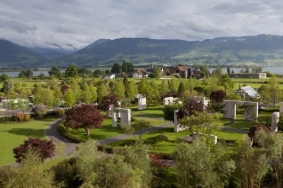
- 나무박물관
- Tree Museum취리히 호수Lake Zurich 상류 근처에 위치한 75,000㎡ 규모의 나무박물관은 타원형의 옥외 박물관으로서 몇 개의 독특하고 개성 있는 공간들로 나누어져 있다. 박물관 내에는 스위스 조경가이면서 나무 수집가로 유명한 Enzo Enea의 수목들이 개별적으로 식재되어 전시되고 있다. 나무박물관의 가장 중요한 임무는 Enzo Enea의 수목들을 통해 이곳을 방문하는 사람들이 공간이나 시간과 같은 삶의 원시적인 속성에 대해 인식하고, 이런 것들이 본질적으로 고대의 숭엄한 나무의 완벽한 전형에 어떻게 뿌리박혀 있는지에 대해 고찰할 수 있도록, 나무의 우수한 존재성과 아름다움 그리고 희귀성을 강조하는 것이다. 나무박물관을 만들게 된 것은 수 년 동안 나무를 세심하게 관찰하고, 나무를 식별하고 다루는 방법에 대해 심도 있는 연구를 진행했던 조경가 Enea의 작품에서부터 자연스럽게 확장된 결과이다. 나무는 단지 그에게 명성을 가져다 준 기반이었을 뿐만 아니라 자연이 만들어 내는 가장 특별한 창조물로서 숭배와 존경심을 서서히 깨닫게 해 주기도 했다. Enea는 이러한 경험을 더 많은 사람들과 공유하고 싶었고, 그간 수집해 온 나무를 나무박물관에 기증하면서 자연에 대한 보존과 보호에 대해 각별한 관심을 나타냈다. 옥외공간의 시공 컨셉은 나무를 선별하여 독립적으로 식재하는 것으로, 이는 방문자들이 식재된 나무를 중심에 놓고 조금 떨어져서 그 주변을 걷게 되면 여러 각도에서 감상이 가능하기 때문이다. The Tree Museum situated on 75,000 square meters of land near Upper Lake Zurich, will officially open its gates. Conceived as an ovalshaped, open-air museum which is divided into a series of ‘ooms‘ each with their own atmosphere and character, the Tree Museum will exhibit individual trees from the collection of Enzo Enea, the Swiss landscape architect and a prominent tree collector. The Museum‘ first mission is to emphasize the exceptional presence, beauty and rarity of the exhibited trees, while on a second, deeper level, Enzo Enea‘ constellations will help shape visitors’perception of primordial attributes of life such as time and space, and how these are so intrinsically embedded in the very quintessence of these ancient, venerable trees.The idea of creating a tree museum was a natural extension to Enea‘ work as a landscape architect as many years of intensely observing and studying trees combined with an increasing understanding of how to sense and handle them not only provided the foundation for his reputation in the field, but also instilled in him a boundless admiration and respect for these most extraordinary creations of nature. In order to share these experiences with a wider audience, Enea decided to indeed dedicate a ”useum”to his trees, thereby implying that they are equally worthy of the care and attention we usually reserve for objects in such an environment. His concept of constructing open-air ‘paces‘ a characteristic of all Enea gardens- allows for trees to be singled out and to become ‘ndividuals‘ as visitors are led to walk around these rooms and to observe them from different angles.Design _ Enea Garden DesignLocation _ Buechstrasse 12, Rapperswil-Jona, SwitzerlandArea _ 75,000㎡Completion _ 2010. 6.



